NEEDS ANALYSIS IN EFL READING CLASS: A STUDY TO PROMOTE LEARNER AUTONOMY THROUGH SELF-ASSESSMENT
Abstract
Teaching EFL reading to the students at colleges or universities requires an appropriate technique that enables students to enhance their achievement as well as to develop their sense of independent learning. This is also to respond to the current trend of that the focus of ELT today is creating learners who are not only competent but also dependent or autonomous in learning. This study is aimed at exploring the needs of both lecturers and students on EFL reading class. The method used was descriptive-qualitative. It was conducted at the English Education Department, Faculty of Teacher Training and Education, Pancasakti University Tegal, from April to June 2018. The participants of this study were 64 students of the fourth semester in the department attending EFL reading class and 4 EFL lecturers. The data were collected using triangulation. The instruments used were a questionnaire, classroom observation, and interview. The results showed that the instruction and assessment were still teacher-centered, the learning materials and the method did not meet the students’ needs, the selection of the materials was not in line with the students’ level of competence, the students were given fewer opportunities to explore and share their ideas with others, etc. The result also showed that both students and lecturers agreed that learning EFL reading through self-assessment could be an alternative learning model or technique to cope with the situations.
Keywords: needs analysis; EFL reading; learner autonomy; self-assessment.
References
Adjoa, N., Yeboah, N., & Mai, M. M. (2016). A needs analysis for a discipline-specific reading intervention. English Language Teaching, 9(3), 235–247. doi: 10.5539/elt.v9n3p235.
Brown, H. D. (2004). Language assessment: Principles and classroom practice (1st ed.). New York: Longman.
Bullock, D. (2011). Learner self-assessment: An investigation into teachers’ beliefs. ELT Journal, 65(2), 114–125. doi: 10.1093/elt/ccq041.
Caldwell, J. S. (2012). Reading assessment: A primer for teachers and coaches. Guilford Press. Saudi Med J, 33. doi: 10.1073/pnas.0703993104.
Illés, É. (2012). Learner autonomy revisited. ELT Journal, 66(4), 505–513. doi: 10.1093/elt/ccs044.
Lianisya. (2014). The use of self-assessment towards students’ reading behavior (A case study). Journal of English and Education, 2(2), 26–35. Retrieved from http://ejournal.upi.edu/index.php/L-E/article/view/4606.
Salam, S. (2017). Developing needs analysis based-reading comprehension learning materials : A study on the Indonesian language study program students. Advances in Language and Literary Studies, 8(4), 105–113. Retrieved from https://files.eric.ed.gov/fulltext/EJ1153681.pdf.
Taufiqulloh, Yuvita, & Sulistianingsih, E. (2018). Analysis of student attitudes to develop a self-assessment model of genre-based writing class. Lingua Cultura, 12(August), 253–258. doi: 10.21512/lc.v12i3.4064.
O’Malley J. M., & Pierce, V. L. (1996). Authentic assessment for English language learners. New York: Longman.
All articles published in English Review: Journal of English Education (ERJEE) are licensed under the Creative Commons Attribution 4.0 International License (CC BY 4.0).
Copyright Ownership
Authors retain the copyright of their articles and grant ERJEE the right of first publication. The journal is granted a non-exclusive license to publish, reproduce, and distribute the article in any format, medium, or platform, provided that proper credit is given to the original authors.
License Terms – CC BY 4.0
Under the Creative Commons Attribution 4.0 International License, others are free to:
- Share — copy and redistribute the material in any medium or format
- Adapt — remix, transform, and build upon the material for any purpose, even commercially
As long as they:
- Provide appropriate credit to the original author(s) and source
- Provide a link to the license (https://creativecommons.org/licenses/by/4.0/)
- Indicate if any changes were made
There are no restrictions on the reuse, reproduction, or adaptation of published articles as long as attribution is properly given.
Author Warranties
By submitting a manuscript to ERJEE, authors confirm that:
- The work is original and does not infringe any existing copyright.
- The manuscript has not been previously published and is not under consideration elsewhere.
- All sources and references are appropriately acknowledged.
- Necessary permissions have been obtained for any copyrighted materials used.









